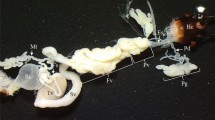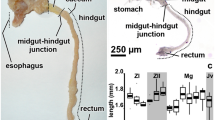Summary
The midguts of Bemisia tabaci and Trialeurodes abutilonea are looped so that the anterior and posterior extremities are in contact with each other. The basal lamina is breached at this point so that opposing basal epithelial membranes of either extremity are contiguous. On the anal side of the contact is a “filter-organ”, consisting of oesophageal, Malpighian and modified ventricular epithelial cells. Comparison with model systems indicates that the filter-organ acts as an osmoregulatory device. It appears that fluid food is directed into the looped midgut and concentrated by passive transport of water across the contact point, through the filter-organ, and then into the hindgut. The filter-organ of both species is attached to the contact point, but in T. abutilonea it is thereafter suspended in the alimentary lumen, free of the alimentary wall. In B. tabaci, the oesophageal cells of the filter-organ are attached to the alimentary wall. This constitutes the major difference in gut histology between the two species. Dissections indicate that the midgut can be moved through the petiole, from the abdomen to the thorax, and back again. This, and the absence of Malpighian tubules, suggests that the midgut services the excretory needs of the flight muscles.
Similar content being viewed by others
References
Brown JK, Bird J (1992) Whitefly-transmitted geminiviruses and associated disorders in the americas and the caribbean basin. Plant Dis 76:220–225
Cheung WW, Marshall AT (1973a) Studies on water and ion transport in homopteran insects: ultrastructure and cytochemistry of the cicadoid and cercopoid midgut. Tissue Cell 5(4): 651–669
Cheung WW, Marshall AT (1973b) Water and ion regulation in cicadas in relation to xylem feeding. J Insect Physiol 19:1801–1816
Chudhry HS, Gupta PC (1970) Studies on the digestive system of Bemisia gossypiperda, M. & L. (Homoptera, Aleyrodidae). The Entomologist 103:49–52
Cohen S, Antignus Y (1994) Tomato yellow leaf curl virus, a whitefly-borne geminivirus of tomatoes. Advances in disease vector research, vol 10. Springer, New York, p 259–288
Deshpande VG (1933) On the anatomy of some British Aleurodidae. Trans Entomol Soc Lond 81(1):117–132
Gildow FE (1982) Coated-vescicle transport of luteoviruses through salivary glands of Myzus persicae. Phytopathology 72:1289–1296
Gildow FE (1985) Transcellular transport of barley yellow dwarf virus into the haemocoel of the aphid vector, Rhopalosiphum padi. Phytopathology 75:292–297
Gildow FE, Gray SM (1993) The aphid salivary gland basal lamina as a selective barrier associated with vector-specific transmission of barley yellow dwarf luteoviruses. Phytopathology 83:1293–1302
Goodchild JP (1966) Evolution of the alimentary canal in the Hemiptera. Biol Rev 41:97–140
Gouranton J (1968) Ultrastructures en rapport avec un transit d'eau. Etude de la “chambre filtrante” de Cicadella viridis L. (Homoptera, Jassidae). J Microsc 7:559–574
Lindley VA (1992) A new procedure for handling impervious biological specimens. Micros Res Tech 21:355–360
Marshall AT (1983) X-ray microanalysis of the filter chamber of the cicada, Cyclochila australasiae Don. Cell Tissue Res 231:215–227
Marshall AT, Cheung WW (1974) Studies on water and ion transport in homopteran insects: ultrastructure and cytochemistry of the cicadoid and cercopoid malpighian tubules and filter chamber. Tissue Cell 6(1):153–171
Mahmood SH (1955) Morphology and biology of the sugarcane whitefly (Aleurolobus barodensis Mask.) in India. Mem Entomol Soc India 4:1–34
Nault R (1989) Leafhopper and planthopper transmission of plant viruses. Ann Rev Entomol 34:503–529
Singh K (1949) On the anatomy of the fourth instar larva (prepupal phase) of the jamun whitefly Dialeurodes eugeniae (Maskell) (Homoptera, Aleurodidae). Indian J Entomol 11:25–46
Weber H (1933) Lehrbuch der Entomologie. Gustav Fischer, Jena, p 390
Weber H (1935) Der Bau der Imago der Aleurodinen. Zoologica (Stuttgart) 89:47–49
Author information
Authors and Affiliations
Rights and permissions
About this article
Cite this article
Cicero, J.M., Hiebert, E. & Webb, S.E. The alimentary canal of Bemisia tabaci and Trialeurodes abutilonea (Homoptera, Sternorrhynchi): histology, ultrastructure and correlations to function. Zoomorphology 115, 31–39 (1995). https://doi.org/10.1007/BF00397932
Accepted:
Issue Date:
DOI: https://doi.org/10.1007/BF00397932




